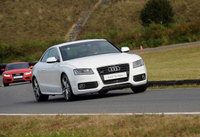Aluminium A5 Coupe shows lighter side of Audi
 A lightweight Audi A5 Coupe prototype has jettisoned over 100kg by swapping steel for advanced aluminium and carbon fibre construction in the interest of fuel economy, emissions reduction and handling agility. The A5 project is the latest example of the pioneering work undertaken by the Vorsprung durch Technik brand to extend efficiency optimisation measures well beyond the engine bay.
A lightweight Audi A5 Coupe prototype has jettisoned over 100kg by swapping steel for advanced aluminium and carbon fibre construction in the interest of fuel economy, emissions reduction and handling agility. The A5 project is the latest example of the pioneering work undertaken by the Vorsprung durch Technik brand to extend efficiency optimisation measures well beyond the engine bay. Taking an existing steel-bodied production car as its basis, the A5 project car clearly demonstrates the benefits of the aluminium Audi Space Frame (ASF) concept with which Audi broke new ground 15 years ago, and which test beds of this kind help to evolve and improve. Use of the ASF principle reduces the weight of a car body by at least 40 per cent compared with conventional steel construction, and this shows in a kerb weight of 1,310kg for the aluminium A5 prototype, versus a total of 1,420kg for the equivalent steel-bodied series production model.
Thanks to the significant weight loss, achieved by mounting aluminium and carbon fibre-reinforced plastics onto the aluminium Audi Space Frame (ASF), the A5 prototype is able to use a four-cylinder engine with its attendant economy and emissions advantages to deliver the performance of a higher output V6.
With the acclaimed 2.0-litre, 211PS Turbo FSI engine, the A5 achieves a power-to-weight ratio of 161PS per tonne. For comparison, the ‘standard’ A5 3.2 FSI V6 quattro with 265PS, which tips the scales at 1,540kg, shades it only by a fraction at 172PS per tonne.
The lightweight design of the test car not only enables a smaller engine to supplement a larger one with no impact on performance and gains in economy and emissions, but also has a knock-on effect on ancillaries such as the brakes and transmission, which can also be reduced in size and weight. It also enables the car to change direction noticeably more keenly and nimbly and, thanks to the reduction in unsprung weight, to ride with even more refinement.

